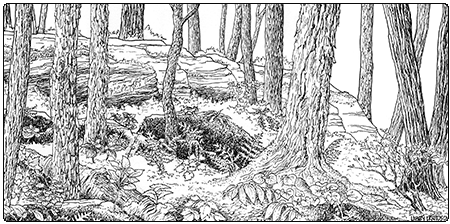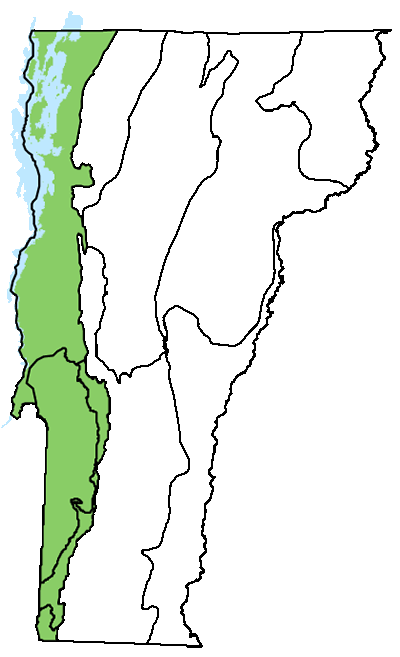Ecology and Physical Setting
Dry Oak-Maple Limestone Forests are found at low elevations in the warmest parts of Vermont. They are found on shallow to bedrock soils on low hills in the Champlain Valley. These bedrock hills rise from the plains of sand or clay that surround them, and although they were mostly under the water of Glacial Lake Vermont, and in some cases also under the Champlain Sea, most of the fine clay sediments that were deposited in those water bodies washed off the hills over time, leaving bare rock. The soft, calcium-rich rock was then weathered over time by water and by the vegetation that colonized it: mosses and lichens at first, and then, as organic matter mixed with weathered rock collected in the cracks, grasses, herbs, shrubs, and trees. Soils are either silt loams or entirely organic soils over bedrock. There can be small pockets of clay interspersed. The pH in the soils is often very high by Vermont standards, usually near neutral and sometimes slightly higher. The bedrock is limestone, marble, dolostone, calcareous quartzite, or calcareous shale.
The relatively warm climate and shallow to bedrock soils make these areas vulnerable to drought stress in dry years, which limits the amount of vegetation that can develop. Mosses growing on the rocks can hold moisture and provide a good substrate for plants, especially walking fern, maidenhair spleenwort, and bulblet fern.
Vegetation
Dry Oak-Maple Limestone Forests are pleasing places to be on an early spring day. They are filled with spring wildflowers, from bloodroot and hepatica early in the season, to large-flowered trillium a little later. Wild ginger flowers hug the ground, the delicate anthers of early meadow rue wave in the breeze, distributing their pollen, and large-flowered bellwort flowers hang and twist gracefully from arched stems. At this time of year, the forest floor is sunny and is warming up, and bumblebees and other insects are about, looking for nectar and pollen. The spring ephemerals do most of their work at this time, flowering, fruiting, and photosynthesizing. As the season progresses, the leaves of sugar maple, red oak, basswood, bitternut hickory, shagbark hickory, white ash, and others, expand to create an almost closed canopy that shades the ground. The plants that keep their leaves throughout the summer—black-seeded mountain rice, blue cohosh, hepatica, large-flowered trillium, broad-leaved sedge, and marginal wood fern, among others—continue to photosynthesize at a slower rate. As late summer approaches, asters and goldenrods send flowering stems up from their basal rosettes on the ground. Blue-stemmed goldenrod is almost always present in this natural community, as is zigzag goldenrod. Large-leaved aster is often present. The plant diversity in these forests is very high—it is easy to walk along and continue to find new plants, hour after hour. Many rare and uncommon plants are associated with this natural community.
Common shrubs include red-berried elder, witch hazel, and maple-leaved viburnum. Leatherwood is present at some sites.
Nearly all the herbaceous plants found in these forests are long-lived perennials. The majority are insect-pollinated, but some of these plants—the grasses and sedges and early meadow rue—are pollinated by wind. The seeds of many wildflowers in this community have fleshy structures, called elaiosomes, that are rich in lipids and proteins, making the seeds attractive to ants. The ants carry the seeds to their nests and feed the elaiosomes to their young. The seeds are left intact and the plant has been dispersed to a new location. Because ants do not travel great distances, plant recolonization after forest clearing can take a long time.
Wildlife Habitat
Dry Oak-Maple Limestone Forests occur as small patches primarily in the highly fragmented Champlain Valley. They provide important deciduous forest habitat. Chipmunks, gray squirrels, and southern flying squirrels are common. Bobcats use these forest patches, especially those with ledges and cliffs that provide secure denning sites. Breeding birds include eastern wood pewee, wood thrush, yellow-throated vireo, black-billed cuckoo, and rose-breasted grosbeak.
American giant millipedes, which are common in this community, incorporate calcium into their tough exoskeletons for protection against predation and desiccation. Millipedes preferentially forage on calcareous leaf litter, and in some forests may be responsible for consuming and cycling up to 20% of the calcium input to the forest.
The rare pillage ant occurs at only one site in Vermont, which is in this natural community. It is a “slave-making” species with an extraordinary behavior and lifestyle. Small raiding parties of four pillage ants enter hollow acorns and other nuts used for nesting by closely related ant species. Using chemical camouflage and a highly efficient and deadly sting, the pillage ants carry away broods and even adult ants to integrate into their slave workforce.
Related Communities
- Mesic Maple-Ash-Hickory-Oak Forest has a similar geographic distribution and many species in common, but is found on deeper, moister soils than Dry Oak-Maple Limestone Forest. These two natural communities can be found adjacent to and intergrading with one another.
- Dry Oak-Hickory-Hophornbeam Forest is generally drier and less diverse than Dry Oak-Maple Limestone Forest. Its ground layer is usually dominated by woodland sedge, and it has fewer spring ephemeral wildflowers.
- Rich Northern Hardwood Forest has many of the same herbaceous species in common, and it also has splendid arrays of spring wildflowers. It lacks oaks and hickories, and the soils are deeper, loamier, and moister. Talls ferns and dense stands of nettle reflect these more mesic soils. Downslope movement is often an important ecological process in Rich Northern Hardwood Forests.
- Oak-Maple Limestone Talus Woodland can be found in association with Dry Oak-Maple Limestone Forest. It is steeper and is dominated by talus, or broken rock fragments.
Conservation Status and Management Considerations
It is likely that many of the limestone hills that support this community were cleared and used for sheep grazing during the heyday of that agricultural practice in the 19th century. Since they are unsuitable as hay land or crop land, the agricultural use was probably brief. They are poor building sites, so in some sense they are naturally protected from major disturbance. Still, disturbances can have long-lasting effects. As is common in many enriched forests that were previously cleared, these are often invaded by non-native species such as common buckthorn, wall lettuce, and honeysuckles.
Dry Oak-Maple Limestone Forests often support concentrations of rare species that require special consideration when planning forest management or recreational uses.
Distribution/Abundance
Dry Oak-Maple Limestone Forests are found on calcareous bedrock at low elevations in the Champlain Valley, Taconic Mountains, Vermont Valley, and, rarely, in the Connecticut River Valley. Similar natural communities can be found in adjacent New York state.
Characteristic Plants
Trees
Abundant Species
Sugar maple – Acer saccharum
Red oak – Quercus rubra
Occasional to Locally Abundant Species
White ash – Fraxinus americana
Basswood – Tilia americana
Shagbark hickory – Carya ovata
Bitternut hickory – Carya cordiformis
Hophornbeam – Ostrya virginiana
White oak – Quercus alba
Bigtooth aspen – Populus grandidentata
Northern white cedar – Thuja occidentalis
White pine – Pinus strobus
Eastern hemlock – Tsuga canadensis
Yellow oak – Quercus muehlenbergii
American beech – Fagus grandifolia
Shrubs and Woody Vines
Occasional to Locally Abundant Species
Red-berried elder – Sambucus racemosa
Maple-leaved viburnum – Viburnum acerifolium
Witch hazel – Hamamelis virginiana
Poison ivy – Toxicodendron radicans
Round-leaved dogwood – Cornus rugosa
Leatherwood – Dirca palustris
Bladdernut – Staphylea trifoliata
Herbs
Abundant Species
Large-flowered trillium – Trillium grandiflorum
Broad-leaved sedge – Carex platyphylla
Early meadow rue – Thalictrum dioicum
Black-seeded mountain rice – Patis racemosa
Bulblet fern – Cystopteris bulbifera
Bishop’s cap – Mitella diphylla
Blue-stemmed goldenrod – Solidago caesia
Zigzag goldenrod – Solidago flexicaulis
Wild ginger – Asarum canadense
Maidenhair fern – Adiantum pedatum
Large-flowered bellwort – Uvularia grandiflora
Sharp-lobed hepatica – Anemone acutiloba
Dutchman’s breeches – Dicentra cucullaria
Occasional to Locally Abundant Species
Thimbleweed – Anemone virginiana
Red trillium – Trillium erectum
Bloodroot – Sanguinaria canadensis
Lopseed – Phryma leptostachya
Marginal wood fern – Dryopteris marginalis
Bottlebrush grass – Elymus hystrix
Lady fern – Athyrium filix-femina
Walking fern – Asplenium rhizophyllum
Woodland sedge – Carex pensylvanica
White snakeroot – Ageratina altissima
Foamflower – Tiarella cordifolia
Kidney-leaved crowfoot – Ranunculus abortivus
Canada violet – Viola canadensis
Pointed-leaved tick-trefoil – Hylodesmum glutinosum
Invasive Non-native Plants
Morrow’s honeysuckle – Lonicera morrowii
Tatarian honeysuckle – Lonicera tatarica
Japanese barberry – Berberis thunbergii
Common buckthorn – Rhamnus cathartica
Oriental bittersweet – Celastrus orbiculatus
Well-lettuce – Mycelis muralis
Rare and Uncommon Plants
Virginia spring beauty – Claytonia virginica
American ginseng – Panax quinquefolius
Handsome sedge – Carex formosa
Downy arrowwood – Viburnum rafinesquianum
Seneca snakeroot – Polygala senega
Wood lily – Lilium philadelphicum
Long-fruited snakeroot – Sanicula trifoliata
Autumn coralroot – Corallorhiza odontorhiza
Back’s sedge – Carex backii
Yellow oak – Quercus muehlenbergii
Purple clematis – Clematis occidentalis
Orange-fruited horse-gentian – Triosteum aurentiacum
Border meadow-rue – Thalictrum venulosum
Ram’s head lady’s slipper – Cypripedium arietinum
Squawroot – Conopholis americana
Sweet Joe-pye weed – Eutrochium purpureum var. purpureum
Muhlenberg’s sedge – Carex muehlenbergii var. muehlenbergii
Graham’s rockcress – Boechera grahamii
Purple-stemmed cliffbrake – Pellaea atropurpurea
Hitchock’s sedge – Carex hitchcockiana
American bittersweet – Celastrus scandens
Stout goldenrod – Solidago squarrosa
Canada buffaloberry – Shepherdia canadensis
Wild comfrey – Cynoglossum virginianum
Short-styled snakeroot – Sanicula canadensis
Spring cress – Cardamine bulbosa
Large toothwort – Cardamine maxima
Golden corydalis – Corydalis aurea
Associated Animals
Southern flying squirrel – Glaucomys volans
Eastern gray squirrel – Sciurus carolinensis
Eastern chipmunk – Tamias striatus
Bobcat – Lynx rufus
Eastern wood pewee – Contopus virens
House wren – Troglodytes aedon
Black-billed cuckoo – Coccyzus erythropthalmus
Wood thrush – Hylocichla mustelina
Yellow-throated vireo – Vireo flavifrons
Wild turkey – Meleagris gallopavo
Red-eyed vireo – Vireo olivaceus
Ovenbird – Seiurus aurocapilla
Scarlet tanager – Piranga olivacea
Hairy woodpecker – Picoides villosus
Rose-breasted grosbeak – Pheucticus ludovicianus
Tufted titmouse – Baeolophus bicolor
American giant millipede – Narceus americanus
Rare and Uncommon Animals
Eastern ratsnake – Pantherophis alleghaniensis
Pillage ant – Temnothorax pilagens
Places to Visit
Niquette Bay State Park, Colchester, Vermont Department of Forests, Parks, and Recreation (VDFPR)
Arms Grant Urban Reserve, Burlington, Burlington Parks and Recreation Department
Kingsland Bay State Park, Ferrisburgh, VDFPR
